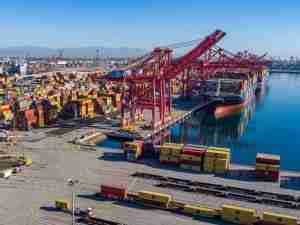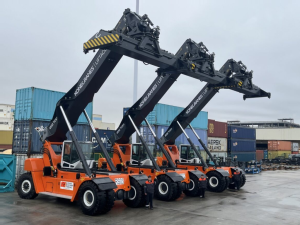APL, a leading global container shipping line, today celebrated completion of two-years of reconstruction at its Oakland, CA, marine terminal, doubling cargo-handling capacity without expanding its footprint.
The project has also improved terminal operating efficiency, permitting future cargo volume growth in Oakland while minimizing environmental consequences.
The milestone achievements were recognized with a reception for 500 employees, customers and maritime industry partners at the Port of Oakland that will include Oakland Mayor Ron Dellums. As part of the ceremony, the terminal will be renamed Global Gateway Central and the Mayor is expected to declare May 20 APL Day in Oakland.
“We’ve talked for years about the need to improve productivity at US ports,” said John Bowe, President of the Americas for the company. “By completing this project we’ve significantly increased our cargo-handling capacity and we’ve done it without adding a single acre of space in Oakland. That’s a dramatic productivity gain.”
The $68 million renovation, jointly funded by APL and the Port of Oakland, is the outgrowth of a long-term lease extension signed by the carrier in 2006. It’s expected to have significant impact for the port and the city of Oakland.
For example, by adding capacity, APL said additional shipping services can now be routed into Oakland. That would mean additional jobs for the city. APL currently employs 500 people in Oakland.
Reconstruction of Global Gateway Central, which took place without ever shutting down operations, increases terminal efficiency by:
- Leveling the property to eliminate a three-foot grade separation that had existed since APL first joined two parcels of land to create its terminal in 1976;
- Eliminating abandoned buildings and reclaiming the vacant land; and
- Redesigning the container yard and redirecting traffic flows through the terminal.
Bowe said terminal renovation at Global Gateway Central meets the city of Oakland’s goal of environmentally responsible growth. By improving efficiency, he said, truckers will be able to get in and out of the facility faster. That will reduce standby time and cut diesel emissions from idling big rigs.
A series of other air-quality improvement initiatives have been introduced at the Oakland terminal. They include the use of cleaner-burning low-sulfur diesel fuel on vessels in port, modernized container-handling equipment that generates fewer emissions and a new lighting system that reduces energy consumption by one-third.
The terminal is also studying a system known as cold-ironing. This enables ships at port to switch off diesel-burning auxiliary engines and eliminate emissions. Instead, they would connect to cleaner shoreside electrical power.
“The global economy is driving growth in containerized trade,” said Bowe. “We’re growing to meet the demand, but we’re doing it in a way that respects the environment and the communities around us.”
Global Gateway Central is one of four marine terminals operated by the company in the US. The others are located in Los Angeles, Seattle and Dutch Harbor, AK.
The terminals are central to APL’s pioneering strategy of transporting US imports to the West Coast, then sending them to final destination via rail or highway. By dramatically increasing Oakland’s capacity, APL said it can offer shippers greater flexibility in selecting a West Coast gateway.









